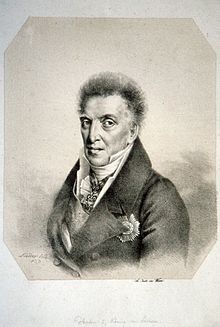Anton (Saxony)

Anton Clemens Theodor Maria Joseph Johann Evangelista Johann Nepomuk Franz Xaver Aloys January, called the Kind (born December 27, 1755 in Dresden , † June 6, 1836 in Pillnitz near Dresden) was King of Saxony from 1827 to 1836 .
Life


He was the fifth son of Elector Friedrich Christian of Saxony and his wife Maria Antonia of Bavaria .
On October 24, 1781, Prince Anton married Princess Maria Carolina of Savoy , who died childless on December 28, 1782 at the age of 18. It was not until five years later, on October 18, 1787, that he married Archduchess Maria Theresia of Austria , daughter of Leopold, Grand Duke of Tuscany, who later became Emperor Leopold II. Together they had four children, who all died shortly after their birth.
Anton succeeded his brother King Friedrich August I , who died without a male heir, as king on the Saxon throne on May 5, 1827. Just six months after his accession to the throne, Queen Maria Theresa died at the age of sixty. The 71-year-old was completely inexperienced in government affairs, so he intended not to push through any radical changes.
Due to the July Revolution of 1830 in France, unrest also began in Saxony in the autumn. These were directed primarily against the traditional estates constitution. On September 13, 1830, Count Detlev von Einsiedel's cabinet resigned. Bernhard von Lindenau followed him. Since the people wanted a younger regent, Anton agreed to appoint his nephew Friedrich August as co-regent of the prince. As a further consequence of the unrest, a new constitution was passed in 1831 , which came into force on September 4th. This made Saxony a constitutional monarchy . The constitution was more conservative than other constitutions in the German Confederation that existed at the time . The king retained his sole sovereignty, but was bound in government business to the participation of the ministers and the decisions of the two chambers of the assembly of estates .
Saxony's accession to the German Customs Union in 1834 allowed trade, industry and transport to flourish further.
Under King Anton, Wilhelm Gotthelf Lohrmann was appointed chief inspector of the Mathematical-Physical Salon in November 1827 and the Technical Educational Institute was founded in 1828 , today's Technical University of Dresden .
souvenir
To commemorate the incorporation of their district, the citizens of Dresden's Friedrichstadt donated a larger than life portrait bust of King Anton in 1835. The bust was made by the sculptor Ernst Rietschel , who depicted the king in the style of the Roman Empire. The bust was cast in the Friedrich-August-Hütte in Plauenschen Grund and set up near the Weißeritz bank. In 1915 it was installed at its current location on Hohenthalplatz in Friedrichstadt and restored in 2000.
Antonsplatz was named in honor of Anton during his lifetime in 1828 , later also Antonstrasse and Antonstadt .
ancestors
literature
- Heinrich Theodor Flathe : Anton (King of Saxony) . In: Allgemeine Deutsche Biographie (ADB). Volume 1, Duncker & Humblot, Leipzig 1875, p. 493.
- Birgit Hilbig: King Anton is back . In: Sächsische Zeitung , May 24, 2000, p. 11.
- Tischner, Wolfgang: Anton 1827–1836, in: Kroll, Frank-Lothar (ed.): The rulers of Saxony. Margraves, Electors, Kings 1089–1918, Munich 2013, pp. 223–236.
Web links
Remarks
- ↑ see e.g. B. Friedrich August Schmidt , Bernhard Friedrich Voigt : New Nekrolog der Deutschen . 18th year, 1840. Part 1, Weimar 1842, p. 224
- ^ Peter Bäumler: Rejection - Petitions - Foundation. WG Lohrmann and the founding of the Dresden Alma Mater . In: Dresdner Universitätsjournal , Volume 14, No. 15, September 30, 2003, p. 12 ( online ); Reiner Pommerin : 175 years of TU Dresden. Volume 1: History of the TU Dresden 1828–2003. Edited on behalf of the Society of Friends and Supporters of the TU Dresden e. V. von Reiner Pommerin, Böhlau, Cologne a. a. 2003, ISBN 3-412-02303-5 , p. 20 ( limited preview in Google book search).
| predecessor | Office | successor |
|---|---|---|
| Friedrich August I. |
King of Saxony 1827–1836 |
Friedrich August II. |
| personal data | |
|---|---|
| SURNAME | Anton |
| ALTERNATIVE NAMES | Anton the Kind; Anton Clemens Theodor Maria Joseph Johann Evangelista Johann Nepomuk Franz Xaver Aloys January |
| BRIEF DESCRIPTION | King of Saxony |
| DATE OF BIRTH | December 27, 1755 |
| PLACE OF BIRTH | Dresden |
| DATE OF DEATH | June 6, 1836 |
| Place of death | Pillnitz |
